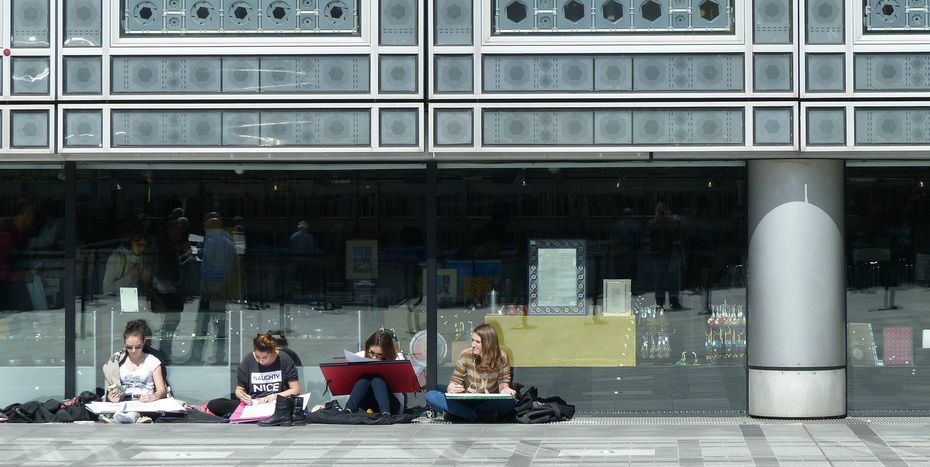
Exhibition « Bonaparte and Egypt» at the Arab World Institute
Published on
On this rainy, dark-grey month of November, strolling along the Parisian docks of the Seine river, is not exactly the kind of activity you would immediately think of doing. Yet, if you bothered, you could come across The Arab World Institute, an amazing mix of Western and Eastern architectures, blending together technical prowesses and muslim traditional patterns. Since the 14 thOctober, this museum located in the 5th arrondissement of Paris presents a huge exhibition dedicated to Napoléon Bonaparte’s campain in Egypt in 1798, faithful to its habit of organizing original art exhibitions, all equally exciting and spectacular. Overview in just a few words… For having been amazed so many times by the really peculiar appearance of this place, I cannot talk of an exhibition that takes place there without talking of the setting in itself. This would, in my opinion, come close to being heretical. Nevertheless, to keep it short, let us focuse on what makes of this institute a one-of-a-kind building: its South side. This side takes up the themes of Arab geometry in the design of the 240 moucharabiehs. These devices provide shade and allow one to see from the inside without being seen from the outside. These shapes, made up of glass and metallical diaphragms, open up and close up according to the outdoor light so as to generate unchanging and permanent light, whatever the weather or the time of day. Ingenious, isn’t it? But let us go back to the heart of the matter…
First look at a peculiar museum
A plunge into an Egypt between myth and reality, tradition and modernity
The tour leads the onlookers along a sinuous but consistent journey consisting of a network of artificial halls which deal with topics following on logically and in an educational way. The visitor starts with a room depicting the way Europeans pictured Egypt on the eve of the French expedition. Tinted with ancient myths and Eastern clichés, the golden picture that Westerners had of the land of the Pharaohs quickly crumbled in the minds of French soldiers who were violently confronted with the reality of the Nile civilization. This is particulary obvious in the second hall of the museum, dedicated to the arrival of the Napoleonic expedition in Egypt. Indeed, sent away from home to block Britain's trade routes to the Middle East and India as well as to bring the ideas of the « Enlightment Age to the East », they received a pretty hostile welcome by an Ottoman province on the decline and ruled by the Mamelouks for about 6 centuries. At the end of a second hall that focuses on the military aspect of the campain, a totally different atmosphere starts. This part deals with the techniques and discoveries made by the numerous scientists arrived with the French army in order to study Egyptians’ nature and culture. A large panel of museum pieces are presented to the watchful eye of the visitor : these run from the description of local customs to archeological works but also to the discovery of the Rosetta stone (the stone that allowed the decipherment of hieroglyph writing some years later). After a short stay in a gallery aimed at showing the emergence of an Egyptian craze in Europe, noticeable in fashion, interior design, furniture, crockery and even Art, one is invited toward the last hall of the exhibition which is dedicated to the future of Egypt in the 19th century after the departure of the French in 1801. Hence, this last hall depicts the incipient relations between the Turkish province and France, notably, during the inauguration of the Suez canal in 1869. This century is the symbol of a renewed European interest in Egypt at a political and commercial level. It is also a century full of interactions between the two civilizations which is depicted in this last hall, one of the most interesting of the museum. At the end of this exhibition, one cannot help but feel satisfied of having rediscovered the well-known unknowns that are depicted through these 30 minutes of touring. Moreover, this exhibition shows that the Eastern campain of Napoleon sat a pattern for the colonialist policy that marked the 19th century. Indeed, Napoleon wanted to assert the so-called French superiority as well as the French influence in Egypt and, as an extension, the European one. How, then, not to see Napoleon’s attempts at developing Egypt technically and economically and indenturing Egypt to the young French Republic as a model revived by Europe through the « civilizing missions » led in the second half of the century? Thus, the issue raised by this exhibition, meant to be rewarding and educational both at a visual and intellectual level, is that of the West relations with the rest of the world. Rich of a large variety of objects and works of art (all equally precious and interesting) the exhibition “Bonaparte and Egypt” turns out to be an undertaking deserving of the highest praise and interest. An exhibition to see without hesitation. Matthieu MolliconeTranslation : Ester Akuzwe Arab World Institute
A good incentive to meditate
Exhibition « Bonaparte and Egypt »
1, rue des Fossées Saint-Bernard Place Mohammed V75005 Paris from October 14th , 2008 to March 29th, 2009



